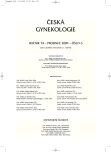Effect of cranberry extract capsules taken during the perioperative period upon the post-surgical urinary infection in gynecology
Authors:
I. Čadková 1; L. Doudová 2; Marta Nováčková 3; I. Huvar 1; Roman Chmel 3
Authors‘ workplace:
Gynekologicko-porodnické oddělení Nemocnice Milosrdných bratří, Brno, primář MUDr. I. Huvar, CSc.
1; Katedra ekonometrie, Fakulta ekonomiky a managementu, Univerzita obrany, Brno, vedoucí prof. RNDr. Z. Zemánek, CSc.
2; Gynekologicko-porodnická klinika 2. LF a FN Motol, Praha, přednosta prof. MUDr. L. Rob, CSc.
3
Published in:
Ceska Gynekol 2009; 74(6): 454-458
Overview
Objective:
To evaluate the effect of cranberry extract capsules taken during the perioperative period upon the post-surgical urinary infection (UTI) in gynecology.
Design:
Clinical prospective pilot trial.
Setting:
Obstetrics and Gynecology Department, Merciful Brothers Hospital, Brno and Obstetrics and Gynecology Department, Charles University 2nd Medical Faculty and Teaching Hospital Motol, Prague.
Materials and Methods:
The cohort consisted of 286 women who underwent hysterectomy and/or anterior vaginal repair (with or without anti-incontinence operation) in the above hospitals in the period 1. 9. 2006 – 30. 6. 2007. 132 women from among the total were given cranberry extract capsules (equiv. 17 000 mg of fresh fruit) twice a day, 4 days before and 5 days after the surgery. The rest were the control group. The clinical state and the analysis of catheterized urine including bacteriology were determined on the day of surgery and on the 6th postoperative day. Cases with preoperative UTI and those with antibiotic therapy (due to other than urology indications) were excluded from the study. Thus the statistical analysis was made in the remaining 117 patients with prophylactic cranberry capsules and 139 controls.
Results:
There were 30.8% of positive cultured urines, 18.0% of pyuric specimens and 6.8% symptomatic urinary infections in the group of cranberry prophylaxis. Controls had significant bacteriuria in 27.3%, pyuria in 23.7% and symptomatic UTI in 5.0%. Differences were not statistically significant.
Conclusion:
The intake of cranberry extracts in the perioperative period (4 days before and 5 days after the surgery) did not affect the number of post-surgical UTIs.
Key words:
UTI (urinary tract infection), CAUTI (catheter associated UTI), cranberry, hysterectomy, vaginal surgery.
Sources
1. Avorn, J., Monane, MS., Gurwitz, JH., et al. Reduction of bacteriuria and pyuria after ingestion of cranberry juice. JAMA 1994, 271, 10, p. 751-754.
2. Čadková, I., Doudová, L., Michálek, J., Huvar, I. Rizikové faktory uroinfekcí po gynekologických operacích. Čes Gynek 2008, 73, 4, s. 241-247.
3. Foo, LY., Lu, Y., Howell, AB., Vorsa, N. A-type proanthocyanidin trimers from cranberry that inhibit adherence of uropathogenic P-fimbriated Escherichia coli. J Nat Prod 2000, 63, p. 1225-1228.
4. Franklin, CL., Fagelman, E. Cranberry juice and urinary tract infections: what is the evidence? Urology 2001, 57, 3, p. 407-413.
5. Garofalo, CK., Hooton, TM., Martin, SM., et al. Escherichia coli from urine of female patients with urinary tract infections is competent for intracellular bacterial community formation. Infect Immun 2007, 75, 1. p. 52-60.
6. Horčička, L., Kolařík, D. Záněty dolních močových cest. In Halaška, M., a kol. Urogynekologie. Praha: Galén, 2004, s. 63-70.
7. Justice, SS., Hung, C., Theriot, JA., et al. Differentiation and developmental pathways of uropathogenic Escherichia coli in urinary tract pathogenesis. Proc Natl Acad Sci U S A. 2004, 101, 5, p. 1333-1338.
8. Kolombo, I. Nekomplikované uroinfekce: co je nového a co se změnilo. Urol List 2005, 3, 2, s. 13-29.
9. Kontiokari, T., Sundqvist, K., Nuutinen, M., et al. Randomised trial of cranberry-lingonberry juice and Lactobacillus GG drink for the prevention of urinary tract infections in women. BMJ 2001, 322, p. 1-5.
10. Mulvey, MA., Schilling, JD., Hultgren, SJ. Establishment of a persistent Escherichia coli reservoir during the acute phase of a bladder infection. Infect Immun. 2001, 69, 7, p. 4572-4579.
11. Naber, KG., Bergman, B., Bishop, MC., et al. Guidelines of urinary and male genital tract infections. European Association of Urology (Update March 2004) (http://www.uroweb.org)
12. Nowack, R., Schmitt, W. Cranberry juice for prophylaxis o urinary tract infections - conclusions from clinical experience and research. Phytomedicine 2008, 9, p. 653-667.
13. Poduška, J. Vliv profylaktického podávání brusinkového extraktu Swiss Natural Sources (tm) MAX brusinky (CRAN-MAX (tm)) 7500 mg na recidivitu infekcí dolních močových cest. Biovit 2005, 5.
14. Rosen, DA., Hooton, TM., Stamm, WE., et al. Detection of intracellular bacterial communities in human urinary tract infection. PLoS Med 2007, 4, 12, p. 329.
15. Rosen, DA., Pinkner, JS., Jones, JM., et al. Utilization of an intracellular bacterial community pathway in Klebsiella pneumoniae urinary tract infection and the effects of FimK on type 1 pilus expression. Infect Immun 2008, 76, 7, p. 3337-3345.
16. Stothers, L. A randomized trial to evaluate effectiveness and cost effectiveness of naturopathic cranberry products as prophylaxis against urinary tract infection in women. Can J Urol 2002, 9, 3, p. 1558-1562.
17. Ševčíková, A., Ševčík, P. Principy antibakteriální léčby u uroinfekcí. Urol List 2005, 3, 2, s. 5-12.
18. Wiles, TJ., Kulesus, RR., Mulvey, MA. Origins and virulence mechanisms of uropathogenic Escherichia coli. Exp Mol Pathol 2008, 85, 1, p. 11-19.
19. Wright, KJ., Seed, PC., Hultgren, SJ. Development of intracellular bacterial communities of uropathogenic Escherichia coli depends on type 1 pili. Cell Microbiol 2007, 9, 9, p. 2230-2241.
20. Zafriri D., Ofek I., Adar R., et al. Inhibitory activity of cranberry juice on adherence of typ 1 an typ P fimbriated Escherichia coli to eucaryotic cells. Antimicrob Agents Chemother 1989, 33, p. 92-98.
Labels
Paediatric gynaecology Gynaecology and obstetrics Reproduction medicineArticle was published in
Czech Gynaecology

2009 Issue 6
Most read in this issue
- Prenatal intracranial hemorrhagie – diagnosis and follow-up
- Amniotic fluid interleukin 6 levels in preterm premature rupture of membranes
- Ovarian torsion in the first trimester gravidity after stimulation in vitro fertilization – case report
- Fertility preserving treatment of gynecological malignant tumors
